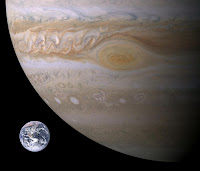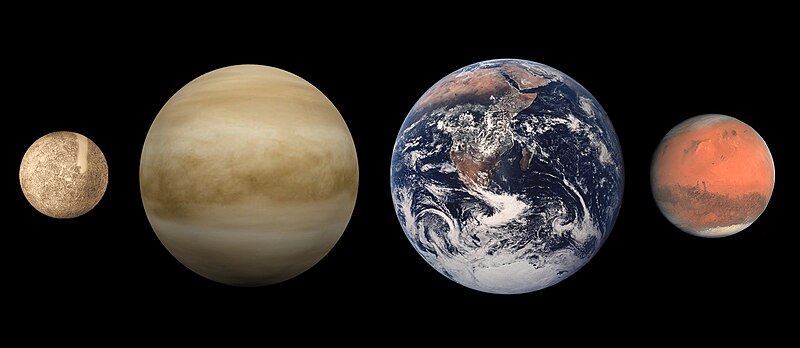One of the biggest questions in science is where did everything come from? It's not an easy question to answer and it may not even be fully answerable with current scientific knowledge.
 |
| A timeline of the history of the universe, from the Big Bang to now. Click to enlarge. |
What we do know, is that the universe started with the Big Bang. The Big Bang was the rapid expansion of the universe in an event a lot like a massive explosion. How the Big Bang got started is still up for debate.
The theory got its start when Edwin Hubble discovered that there were other galaxies outside our own and that the universe was expanding. Since the universe is expanding, it means that at some point the universe must have been much, much smaller than its current size.
At the very beginning, when the universe was still very small, it was extremely hot and dense. It was essentially a hot "soup" of particles, so hot that atoms would not be able to hold together. There isn't a lot of observational evidence for these early moments, but the theory thoroughly explains what happens shortly after.
Before we burn our tongues trying to test this particle soup, let's move on to some more testable events.
A small fraction of a second after the Big Bang, some particles began to group together to form larger particles. Quarks, an abundant ingredient in the particle soup, then grouped together to form neutrons and protons, the building blocks of atoms.
Between three and twenty minutes later, neutrons and protons combined together to form the nuclei, or centers, of atoms. The exact amount of Hydrogen and Helium predicted to have formed by the Big Bang Theory matches up exactly with what is measured by astronomers.
But it's not until 379,000 years after the Big Bang that electrons finally begin to orbit the nuclei, to form the first true atoms. The temperature was now a cozy 3000°C. After this moment, light particles, known as photons, are finally able to freely move without instantly colliding with something.
An interesting thing about light particles is that they have a specific wavelength, or energy, depending on the temperature of the substance they were emitted from. A hot burner glows red because of the energy of light emitted by that temperature.
 |
| An image of the cosmic microwave background taken by the WMAP mission. Click to enlarge. |
Due to the expansion of the universe and the time these photons have been traveling through space, their wavelengths have been stretched out, resulting in a much lower energy. The temperature of the photons should now be approximately -270°C, 3°C above absolute zero, the coldest possible temperature. These photons are now referred to as the cosmic microwave background.
American radio astronomers Arno Penzias and Robert Wilson discovered the cosmic microwave background in 1964 at nearly the exact predicted energies.
Millions of years after the Big Bang, stars began to form and galaxies also began to clump together. The James Webb space telescope will check for these early stars once it is launched in 2015.
 |
| The Hubble deep field, an image of the early universe taken by the Hubble Space Telescope. |
The ages of the oldest current stars and how fast the universe is expanding both agree on the age of the universe. The Big Bang Theory has held up to all tests so far and refinements to measurements are being made all the time. This is an exiting and truly bizarre universe that we live in.
Maybe someday we will know how it all started, but until then, let's see what's up in this month's sky.
The new Moon is on Dec. 5, which will become a full Moon by Dec. 21. On Dec. 21, there will be a total lunar eclipse after midnight, where the Moon will slowly change to a very dark red.
Also on Dec. 21 is the winter solstice, considered to be the first day of winter.
On the night of Dec. 13 and the morning of Dec. 14 is the Quadrantid meteor shower. This shower may very well be the best meteor shower of the year with up to 120 meteors per hour predicted. No one likes a cold shower in the winter; so make sure to dress warmly.
Jupiter will be in the southern sky, dominating the evening sky throughout the month. In the morning sky, Venus will be shining brilliantly bright, low the southeast. Saturn will be a little to the west of Venus, accompanying it throughout the month.
Mercury will try to make a showing at the very end of the month, but will be very hard to pick out low in the east right before sunrise.
The Athena Community Astronomy Club will be having their annual Christmas meeting on Dec. 12 at the Wilmot Community Centre from 7pm to 9pm. Friends, family, and newcomers are always welcome.
Until next month, just look up!
Hey Kids...
Did you know that you can see leftover radiation from the beginning of the universe? If you have an old TV kicking around with the "bunny ears" on top and set it to one of the fuzzy channels, a small amount of that fuzzy image, about 1%, is from the Big Bang. The Big Bang was the explosion that is believed to have been the start of the universe. It doesn't take fancy equipment to do science, just a little interest and some imagination.















.jpg)
.jpg)









